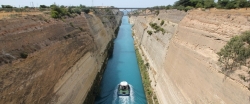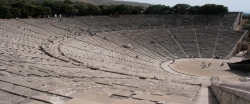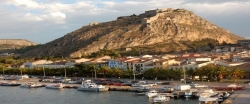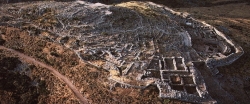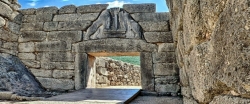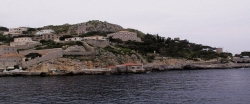Le nostre destinazioni più richieste
I nostri tour:
Common description
Argolis is a historical region, in the Eastern Peloponnese. It is an area where you can breathe history, literature and art. Some of the most important archaeological sites in all of Greece are located here, just an hour and a half from Athens.
What to see and what to do: our suggestions
Corinth – The archaeological site of Corinth is 9 km from the modern city. There are the Temple of Apollo and the temple of the goddess Tyche (the personification of luck). The archaeological museum houses a rich collection of artefacts and objects, dating back to the prehistoric period up to the Roman and Byzantine periods. The castle of Acrocorinth, with its medieval walls, is located on the hill and is considered one of the largest and most impressive castles in the Peloponnese. The Corinth Canal, which connects the Ionian Sea with the Aegean Sea, was built in recent times, between 1881 and 1893. The canal, which allows avoiding the circumnavigation of the Peloponnese region, is over 6 km long, 25 km wide m deep 8 m.
Mycenae – It is the Homeric city par excellence, that of King Agamemnon. Discovered by Heinrich Schliemann only in 1874, Mycenae is one of the greatest urban masterpieces of the Mycenaean age. Perched on a hill overlooking the surrounding plain, it is surrounded by cyclopean walls in which the famous Porta dei Leoni opens.
Epidaurus – It was the seat of the sanctuary of Asclepius, one of the most important places of worship in ancient Greece. Like any self-respecting spiritual center, it also included a theater and a stadium. The Theatre, which has remained almost intact, is one of the oldest in Greece and is still used today with its original function. Built in 360 BC, it is dug on the slopes of a hill of great naturalistic beauty. It is renowned for a peculiar characteristic: the Theater of Epidaurus offers perfect acoustics. The voice can be heard perfectly from any position in the auditorium. Every year it hosts a theater festival, which aims to revive the great Greek tragedies, and many concerts.
Nauplia – It is a very picturesque town, with a historic center with narrow streets, elegant Venetian homes and neoclassical buildings. The port, with its fishermen, is of great charm. Its symbol is the Venetian Castle of Bourtzi, a rocky islet off the coast of the city dating back to 1400. The other two strongholds of the city are Acronafplia and the Palamídi Fortress, which were included in the city's defense circuit against pirate attacks via sea.
Where it is located and how to reach Argolis
Where to find it : Argolis is located on the Peloponnese peninsula, on the eastern side.
How big it is : 2140 sq km. The capital is the city of Nauplia.
By plane: Athens Airport, then 130 km west via the Corinth Canal.
What to see and what to do: our suggestions
Corinth – The archaeological site of Corinth is 9 km from the modern city. There are the Temple of Apollo and the temple of the goddess Tyche (the personification of luck). The archaeological museum houses a rich collection of artefacts and objects, dating back to the prehistoric period up to the Roman and Byzantine periods. The castle of Acrocorinth, with its medieval walls, is located on the hill and is considered one of the largest and most impressive castles in the Peloponnese. The Corinth Canal, which connects the Ionian Sea with the Aegean Sea, was built in recent times, between 1881 and 1893. The canal, which allows avoiding the circumnavigation of the Peloponnese region, is over 6 km long, 25 km wide m deep 8 m.
Mycenae – It is the Homeric city par excellence, that of King Agamemnon. Discovered by Heinrich Schliemann only in 1874, Mycenae is one of the greatest urban masterpieces of the Mycenaean age. Perched on a hill overlooking the surrounding plain, it is surrounded by cyclopean walls in which the famous Porta dei Leoni opens.
Epidaurus – It was the seat of the sanctuary of Asclepius, one of the most important places of worship in ancient Greece. Like any self-respecting spiritual center, it also included a theater and a stadium. The Theatre, which has remained almost intact, is one of the oldest in Greece and is still used today with its original function. Built in 360 BC, it is dug on the slopes of a hill of great naturalistic beauty. It is renowned for a peculiar characteristic: the Theater of Epidaurus offers perfect acoustics. The voice can be heard perfectly from any position in the auditorium. Every year it hosts a theater festival, which aims to revive the great Greek tragedies, and many concerts.
Nauplia – It is a very picturesque town, with a historic center with narrow streets, elegant Venetian homes and neoclassical buildings. The port, with its fishermen, is of great charm. Its symbol is the Venetian Castle of Bourtzi, a rocky islet off the coast of the city dating back to 1400. The other two strongholds of the city are Acronafplia and the Palamídi Fortress, which were included in the city's defense circuit against pirate attacks via sea.
Where it is located and how to reach Argolis
Where to find it : Argolis is located on the Peloponnese peninsula, on the eastern side.
How big it is : 2140 sq km. The capital is the city of Nauplia.
By plane: Athens Airport, then 130 km west via the Corinth Canal.

